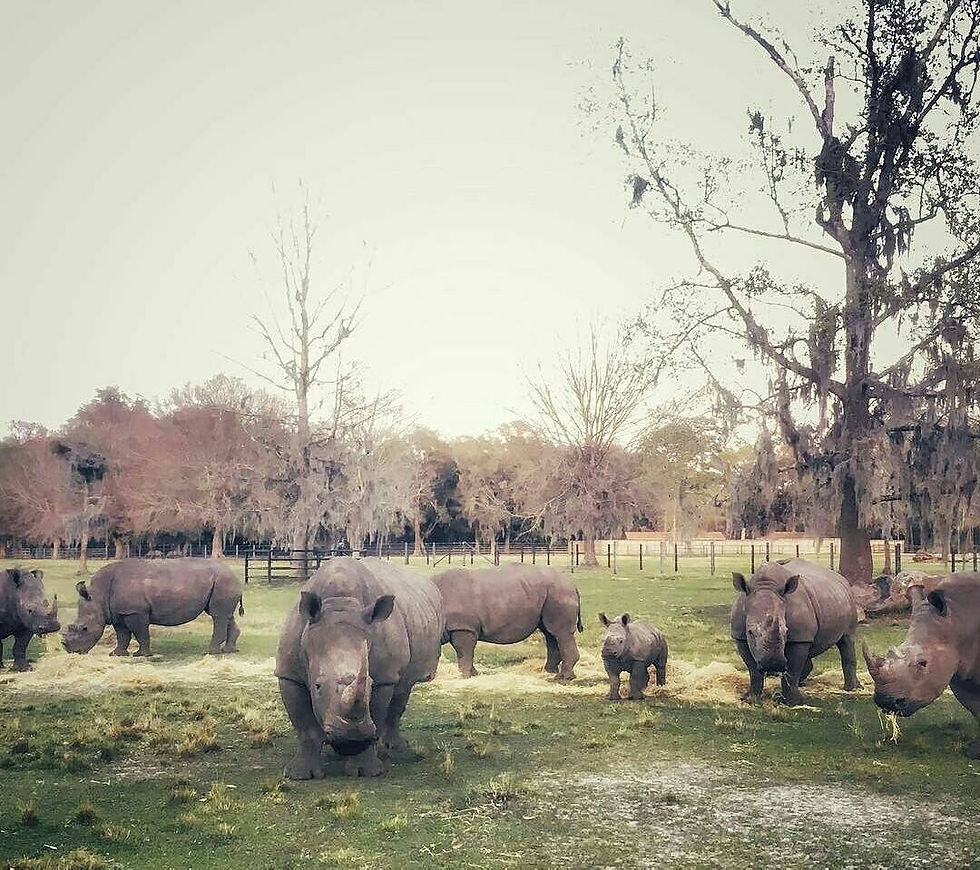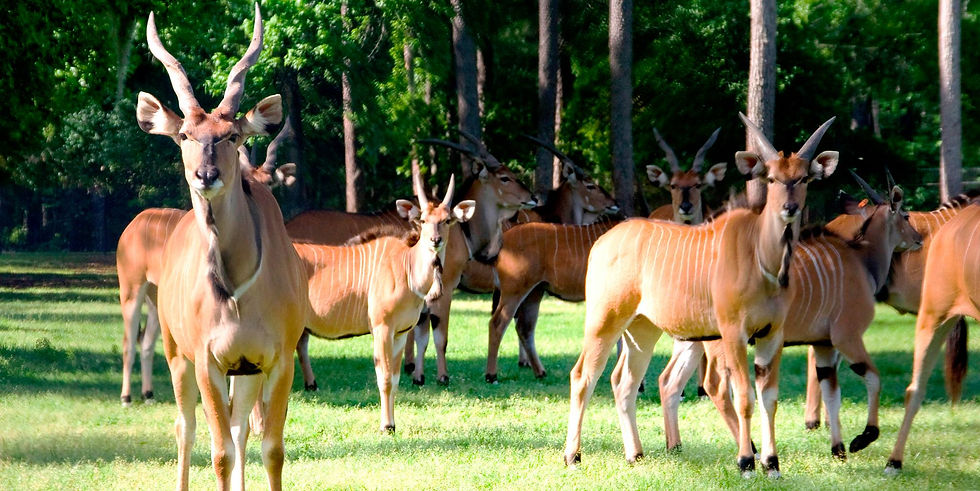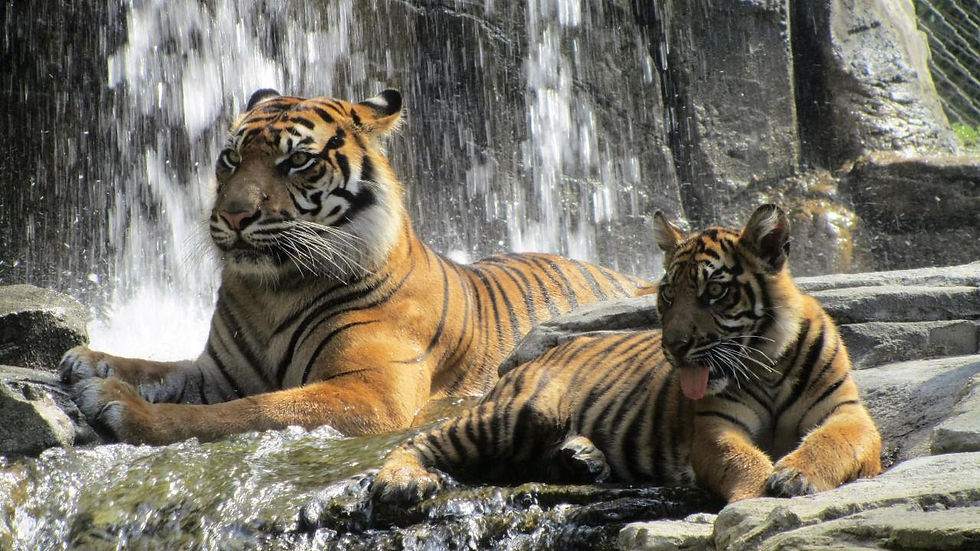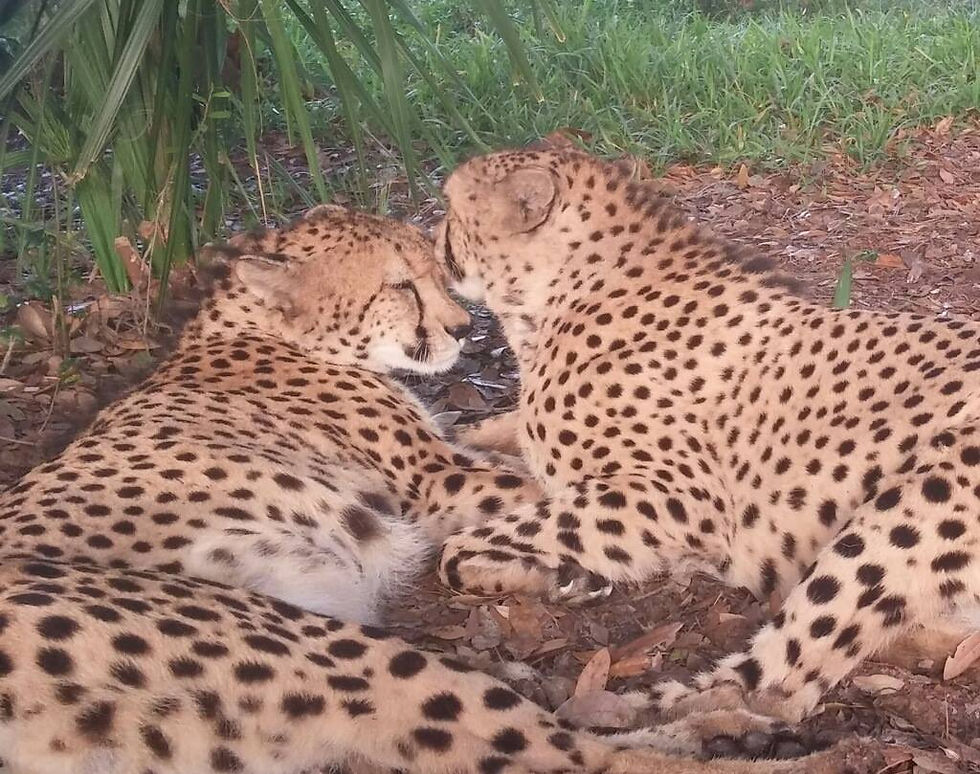The Champion of the Ghost of the Forest: A Conversation with John Lukas, Former Director of White Oa
- Grayson Ponti
- Apr 11, 2018
- 10 min read
During his thirty years as Director of White Oak Conservation, a conservation center and breeding facility for endangered species in Yulee, FL, John Lukas left a significant mark on reproductive science and sustainability of a variety of endangered species, notably white rhinoceros, cheetahs, Grevy's zebras and okapi. He made sure one dollar for every two dollars spent on animal care at the facility went to saving species in the wild. Lukas founded the International Rhino Foundation and the Okapi Conservation Project (he is considered the world authority on okapi.) He currently serves as Conservation Manager at the Jacksonville Zoo. Here is his story.

@ Jacksonville Zoo
John Lukas’ career in zoos began working at a zoo in Hartford, CT during the summers while he was in college. While in graduate school he worked as a night watchman at the Children’s Zoo in Boston. After spending some time working at the Stone Zoo and as Assistant Director of the Children’s Zoo at the Franklin Park Zoo, he moved to Canada to work at the Okanagan Game Farm in British Columbia. Unlike a traditional zoo, the game farm was encompassed a mountain side and featured animals living in vast open spaces. “That’s where I got my concept for large spaces,” Lukas remembered. “We had to manage animals in big areas which has its pluses and minuses.”

@ White Oak Conservation
Lukas would then go to the New York Zoological Society (now Wildlife Conservation Society) to start up the Saint Catherine’s Wildlife Survival Center, an offsite breeding facility on an island off the coast of Georgia managed by the Bronx Zoo. “It started as a breeding center with many zoos providing animals requiring cooperation between zoos,” he elaborated. Lukas was responsible for building the center, which would feature big large spaces for hoofstock, lemurs, rare birds and a variety of other animals. One of the perks of Saint Catherine’s was it was extremely isolated and could only be reached by boat. “When I would go to New York City once a month to report, I would stay in William Beebe’s library and would bring his books by explorers that had traveled the world back to the island to read,” Lukas recalled. “That’s how I got exposed to exotic places like the Congo.”

@ White Oak Conservation
While leading a safari for NYZS, Lukas, met Howard Gilman, whose family ran the Gilman Paper Company. Gilman was a wealthy philanthropist who wanted to do something for conservation. “Mr. Gilman asked me to look at his place in Florida,” Lukas recalled. The plantation was home to several species of hoofstock on 7,000 acres in Yulee, Florida. Lukas came down to advise on enclosure and corral design for the hoofstock but soon enough was asked to join the plantation full-time. In 1982, Lukas moved down to Florida and White Oak Conservation Center was born.

@ White Oak Conservation
As Lukas built White Oak, he thought about the species that would most benefit from what it had to offer. “The concept was to have animals that benefited from the large spaces, privacy and climate,” he elaborated. “I wanted species where we could provide conditions to allow them to express 90% or more of their natural behavior.” In 1982, Lukas brought in white and black rhinoceroses, cheetahs and Grevy’s zebras, all of whom were not breeding well in zoos. Lukas was determined to use the center to crack the codes needed to get these endangered species to successfully propagate.

@ White Oak Conservation

@ White Oak Conservation
While White Oak was perfectly tailored to managing animals in a natural setting, it was not designed for guests and little was done in the way of aesthetics. “We didn’t want to make any concessions to the animals’ needs,” Lukas remarked. “Everything was built [exclusively] to benefit the animals. everything was natural- the trees, the mud wallows.”

@ White Oak Conservation

@ White Oak Conservation
Soon, Lukas made several discoveries related to cheetah reproduction. “We began to understand cheetah biology,” he explained. “We housed them in large isolated places and separated the sexes, [which is essential for mating.] and gave the females choices of mates. You need staff who can read cheetah behaviors. The cheetahs did very well long before they did at other zoos.” Over 180 cheetahs have been born at White Oak and, in recent years, other facilities have had success breeding cheetahs after emulating the management style done by White Oak.

@ White Oak Conservation

@ White Oak Conservation
White Oak would also become famous for its great success with white and black rhinos. “To breed rhinos, you need the right combination,” Lukas stated. “You need to incorporate the natural history of these animals. For black rhinos, solitary management mimics their natural behavior. You need to do a careful introduction [for mating] when the female is in estrus. White rhinos are social if you have one male. Indian rhinos are in between.” As with cheetahs, White Oak was vital for establishing sustainable a population of white rhinos in North America.

@ White Oak Conservation

@ White Oak Conservation
Grevy’s zebras, notorious in zoos for their aggressive demeanor, became another signature species of White Oak. “Grevy’s are tough as there is no bond between the male and female and the males are territorial,” Lukas explained. “In captivity, you need space as the male runs the female very hard prior to breeding. In small areas, they can be overly aggressive and hurt the females.” Over 70 Grevy’s zebra foals have been born at White Oak.

@ White Oak Conservation

@ White Oak Conservation
In 1987, White Oak began breeding giraffes in large herds. “We could keep the giraffes together all the time,” Lukas said. “There was no separation and the hierarchy flowed naturally. We did very well with them.” The same year, White Oak became involved with okapis, the closest relatives of the giraffe and a species whose conservation Lukas would become synonymous with. “I thought our climate and thick forests would be perfect for okapis,” Lukas elaborated.

@ White Oak Conservation
Known as the ghosts of the forests, okapis had proven very difficult to breed in a zoo setting. “The genetics of okapis [in zoos] had a lot of inbreeding,” Lukas explained. “No one was doing well with them.” The first okapi birth in America was at the Brookfield Zoo in 1957 but over time subsequent births, because of low founder numbers, produced animals that were related. White Oak staff worked with the government of the Democratic Republic of the Congo to bring in imports that were born in Zaire to improve genetic diversity. We also returned okapi to the wild from our breeding facility in the Democratic Republic of the Congo. We bred okapi at White Oak and sent the offspring around the world.” Lukas cited okapi as an example of how a few new founder animals a generation can reinvigorate a population.

@ White Oak Conservation
As a result of White Oak’s success with the species, there are now four times as many okapis in American zoos prior to the imports in 1991. Even more impressive, White Oak’s program evolved into the Okapi Conservation Project, which Lukas founded. “The Okapi Conservation Project protects rainforest and prevents human disturbances like bushmeat snaring, mining, slash and burn agriculture and logging” he stated. “We support Wildlife Rangers that evacuate miners, collect snares and arrest poachers. We start with a peaceful approach, first confiscating tools and evacuation out of the Reserve then if you return you are arrested.” Zoos support the Okapi Conservation Project by providing financial support and marketing awareness of the plight of the okapi. The Okapi Project started World Okapi Day (Oct 18) to talk about the plight of the ghost of the forest. Lukas noted the okapi are the flagship species of a tract of rainforest containing the highest density of primate species in Africa.

@ White Oak Conservation

@ White Oak Conservation
White Oak Conservation Center became an important resource for Species Survival Plans and ISIS (now Species360) in creating healthy, sustainable populations for zoos. “We could be a resource as we had the space,” articulated Lukas. “We also could hold large numbers of males to increase genetic options for breeding and large numbers of each species. Numbers are just as important as genetics [in maintaining sustainable populations.} We hosted lots of SSP and CBSG (Conservation Planning Specialist Group) meetings over the years to improve management of species under human care.”

@ White Oak Conservation
Sustainable populations in human care are not just vital to maintaining animals in zoos but also providing insurance populations for the wild. “Sustainable populations provide options in the future,” explained Lukas. “We can’t save a species with only a few animals. The ambassador role of animals in zoos is very important to saving species in the wild but sustainable populations also keep the possibility of reintroduction open.”

@ White Oak Conservation
White Oak specialized in the propagation of a variety of hoofstock species including dama gazelles, bongo, gerenuk, lesser kudu, Nile lechwe, roan antelope and slender-horned gazelles. With limited space, Lukas strongly felt zoos and conservation centers should focus on antelope species that were threatened and endangered. “We need to save priority species for reintroduction,” he claimed. “Scimitar-horned Oryx came back to Chad because we built a healthy global population. We need to discern what species we work with. Should we work with waterbuck and impala when they are not endangered or endangered species in need of help? You need to have a one plan approach on how to contribute to the conservation of a species. Zoos have to look at one plan and decide where they can best help be it, research in the field, helping secure habitat or mange populations to be invested in conservation.”

@ White Oak Conservation
“We worked hard to insure that all the animals at White Oak were of value to their species.” Lukas continued. A number of animals from White Oak ended up being sent back to the wild. “We sent bongo to Mount Kenya,” Lukas recalled. “We sent a black rhino back to South Africa and he did very well siring many calves.” The key to reintroduction is making sure the natural habitat is under protection. For instance, we sent roan antelope back to South Africa and the adults were managed in small enclosed areas. Then their wild born offspring were released into larger and larger areas over time. You contain the naïve zoo born animals to a small space and release the offspring whose instincts guide them in settling into a life in the wild.”

@ White Oak Conservation

@ White Oak Conservation
One of Lukas’s priorities for White Oak was maximizing the dollars that went to field conservation. “For every two dollars we spent on animal care at White Oak, we spent one dollar protecting animals in the wild,” he explained. “It was my goal to spend equal amounts on species in the wild as we did caring for animals here. Managed populations have to have a purpose and we need to show what that purpose is.”

@ White Oak Conservation

@ White Oak Conservation
White Oak was a founding member of Conservation Centers for Species Survival (C2S2), a coalition of zoos and breeding centers in North America devoted to building healthy, adaptable populations of endangered species. C2S2 is predominantly made up of conservation centers in North America with thousands of acres such as White Oak, Fossil Rim Wildlife Center, Smithsonian Center for Biodiversity Conservation and the Wilds. “We all led by example and had a different approach,” recalled Lukas. “We started it to facilitate a collaborative organization for big space zoos to work together. We have the space in North America to save species in peril [and need to use it.]”

@ White Oak Conservation

@ White Oak Conservation
In the 1990s, Lukas was asked by his friend Rick Barongi to serve on the Advisory Board for Disney’s Animal Kingdom, a new park that would embrace modern animal husbandry and the values of conservation. He served on the board for years alongside visionaries in the zoo and conservation fields such as Bill Conway, Russ Mittermeier, Terry Maple, Ted Beattie and the late Mike Hutchins. “That was a very educational experience as I was with the finest minds around,” Lukas remembered. “Disney listened to us and made adjustments [for animals], which is why they are so successful. They built remarkable in house capacities for conservation.”

@ White Oak Conservation

@ White Oak Conservation
In 1998, Howard Gilman passed away. “After he died, the Howard Gilman Foundation took over the management of White Oak,” Lukas stated “The original board had all been handpicked by Howard and stayed true to his vision.” When the board decided to sell White Oak in 2012, Lukas decided to move on from White Oak. “I was a steward of Howard Gillman’s vision and philanthropy,” he reflected. In 2013, White Oak was purchased by Mark Walter, owner of the Los Angeles Dodgers, and his wife Kimbra which have continues to support the operation of the animal programs.

@ White Oak Conservation

@ White Oak Conservation
After leaving White Oak, the Jacksonville Zoo and Gardens offered to provide an office for John from which to direct the Okapi Conservation Project. Soon, however, the zoo’s director Tony Vecchio invited him to join the staff full-time as Conservation and Science Manager. Lukas would help strengthen the zoo’s efforts to saving wildlife and wild places. “Conservation was important to the zoo but had been unorganized,” he recalled. “The first thing I did was hold workshops with staff and experts to help create a conservation strategic plan.”

@ Jacksonville Zoo
The decision was made to focus half of the Jacksonville Zoo’s conservation budget on selected biodiversity hotspots which maximize your impact on species conservation. “One pillar goes to Florida projects such as manatees, Florida panthers and wood storks,” Lukas elaborated. “The third pillar supports programs related to high priority species at the zoo such as tigers, elephants, lions, komodo dragons and cheetahs.”

@ Jacksonville Zoo

@ Jacksonville Zoo
Lukas integrated staff members throughout the zoo into the conservation process. “We require a staff member to champion each project,” he stated. “Each month, we meet to decide which programs we will support and the champions lobby the committee for support of their project. As important we regularly monitor the impact of the programs we fund. At the zoo, all of our staff understands the role of conservation in building our brand as a leading zoo committed to saving species everywhere. The next challenge is getting the word out to our local community. We do that through things like celebrating species days, hosting a conservation gala and inviting them to attend our conservation speaker series.”

@ Jacksonville Zoo

@ Grayson Ponti
In addition to starting the Okapi Conservation Project, Lukas was a founding member of the International Rhino Foundation and currently serves as its President. “The International Rhino Foundation works with all five rhino species, particularly the three Asian species,” he elaborated. “It supports protection, research and demand reduction.”

@ Grayson Ponti
Lukas reflected on his vision of the future of zoos. “We will have fewer zoos and the ones that will remain will resonate with the community, have larger, more engaging habitats and be making a difference,” he articulated. “Zoos will be the public face for conservation.” He saw both Jacksonville Zoo and Gardens and White Oak Conservation Center as examples of the zoo of the future. In particular, Lukas saw a need for more zoos to have large offsite breeding centers. “It is easier to manage animals in numbers,” he remarked. “There will be more of a reliance on offsite breeding facilities to maintain large numbers of important species.”

@ Jacksonville Zoo

@ Jacksonville Zoo
“I’m most proud of the movement started at White Oak in animal management,” John Lukas concluded. “I’m also proud of helping start the Okapi Conservation Project, the International Rhino Foundation and the Wildlife Conservation Network and serving on many boards to advance the cause of institutions working to save life on this planet as we know it.”

@ Grayson Ponti






Comments